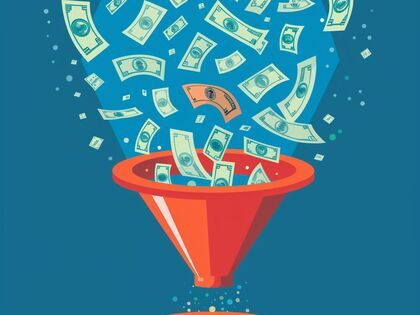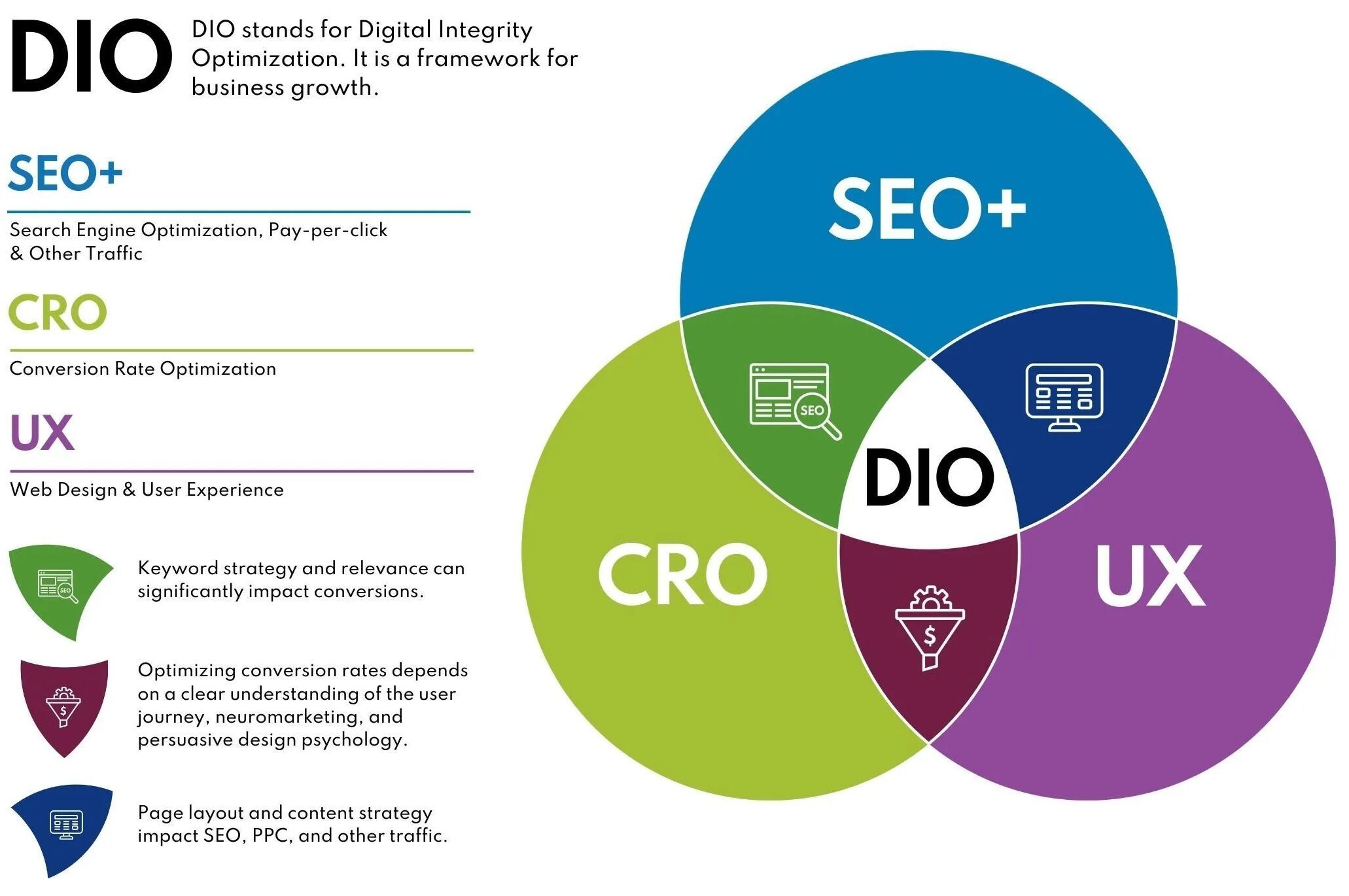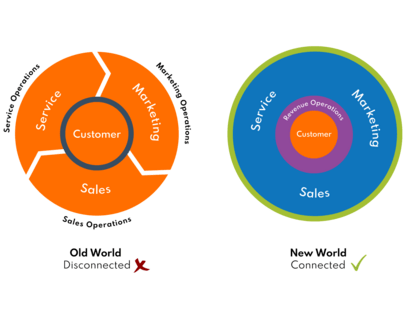Results-Driven Marketing: Maximizing B2B Marketing ROI with a Holistic Approach

- Utilize the Digital Integrity Optimization (DIO) framework to integrate SEO, UX design, and CRO for a comprehensive and effective digital marketing strategy.
- Adopt a holistic marketing approach by aligning ABM, RevOps, GTM, and DIO for enhanced operational efficiency and substantial marketing ROI.
- Empower departments to work seamlessly by implementing Revenue Operations and Go-to-Market strategies that align shared goals and metrics.
- Leverage data-driven insights to refine marketing campaigns and ensure targeted, efficient, and effective engagement with high-value accounts.
In an era where the digital landscape evolves at an unprecedented pace, businesses are constantly seeking innovative strategies to enhance their marketing return on investment (ROI). The key to achieving this lies not in isolated tactics but in a cohesive, results-driven approach that seamlessly integrates various specialized strategies.
Results-Driven, Holistic Marketing
Enter the realm of holistic marketing—a strategy that transcends traditional marketing efforts to create a unified results-driven approach geared especially towards B2B marketing.
Within this expansive framework, Account-Based Marketing (ABM), Go-to-Market Strategy (GTM), and Revenue Operations (RevOps) emerge as critical components, each playing a pivotal role in aligning marketing and sales efforts toward high-value targets and operational efficiency.
However, to truly maximize marketing ROI, we must also introduce the concept of Digital Integrity Optimization™️ (DIO), a framework created by O8 to define what good digital marketing truly is. This framework is designed to address a fundamental question: What good is driving traffic to your website if that traffic doesn't convert? Or, conversely, what is the value of a high-converting website if it remains unseen?

The DIO framework harmonizes three essential pillars—SEO and paid advertising, UX and design, and conversion rate optimization (CRO)—into a unified strategy that ensures your marketing efforts are not just seen and experienced but are also effective in converting visitors into customers. This integrative approach encapsulates the essence of maximizing marketing ROI through holistic marketing.
By understanding and implementing ABM, RevOps, GTM, and the DIO framework as interconnected gears of a larger machine, businesses can forge a path to not just incremental improvements but exponential growth. The following sections will delve deeper into how these components interplay within the holistic marketing strategy, their individual contributions, and how, when combined, they can transform your digital marketing efforts into a powerhouse of efficiency and effectiveness.
Examining Three Components of Holistic Marketing: ABM, RevOps + GTM, and DIO
At the heart of a successful B2B digital marketing strategy lies the union among ABM, RevOps, GTM, and the DIO framework. When integrated within a holistic marketing approach, these components work in concert to create a powerful, unified strategy that drives unparalleled marketing ROI and business growth.
1. ABM as the Precision Tool in Targeting High-Value Accounts
Account-Based Marketing (ABM) serves as a precision tool within holistic marketing, targeting high-value accounts with tailored strategies that resonate on a more personal and impactful level. Unlike traditional broad-spectrum marketing efforts that scatter resources in hopes of attracting leads, ABM focuses on identifying and engaging specific accounts or customer segments that offer the highest potential return on investment. This targeted approach allows for a more efficient allocation of marketing resources, ensuring that efforts are concentrated where they are most likely to yield significant business outcomes.

Deep-Diving into High-Value Accounts
ABM starts with a deep dive into data to identify which accounts are considered high-value. These accounts are typically those that have the potential for higher lifetime value, greater deal sizes, strategic significance, or are a perfect fit for the company's products or services. By leveraging data analytics and insights, ABM strategies can pinpoint these key accounts, understanding their unique needs, challenges, and business goals.
Personalization at Scale
One of the core strengths of ABM is its ability to personalize marketing efforts at scale. By understanding the specific attributes and needs of each high-value account, marketers can create customized campaigns that speak directly to the pain points and aspirations of the targets. This level of personalization extends beyond just addressing the account by name; it involves tailoring the messaging, content, and even the marketing channels used, to align with the account's preferences and behavior. Such targeted personalization fosters stronger relationships and engagement, significantly increasing the likelihood of conversion.
Aligning Sales and Marketing
ABM requires a close alignment between sales and marketing teams, a synergy that is essential for targeting high-value accounts effectively. Sales teams possess valuable insights into the accounts' needs and challenges, which can inform the development of highly resonant marketing strategies. This collaboration ensures that marketing efforts are not only tailored but also timed perfectly to complement the sales process, enhancing the overall impact on the target accounts.
Leveraging Multi-channel Strategies
ABM doesn't rely on a single channel to engage high-value accounts. Instead, it employs a multi-channel strategy that ensures messages reach the targets through the most effective and preferred channels. This might include targeted social media ads, personalized email marketing, bespoke content marketing, direct mail, and even personalized events or webinars. The choice of channels is driven by insights into the account's preferences, ensuring that each interaction adds value and builds upon the last, creating a cohesive and compelling narrative.
Measuring Success and ROI
The targeted nature of ABM allows for more precise measurement of marketing efforts' effectiveness and ROI. By focusing on a select group of high-value accounts, it's easier to track engagement, conversion, and the overall impact of marketing strategies. This data-driven approach to measurement not only demonstrates the value of ABM but also provides insights that can be used to refine and optimize future campaigns.
In summary, ABM stands as a precision tool within a holistic marketing framework, enabling businesses to target high-value accounts with customized, insightful, and impactful marketing strategies. By focusing resources on the accounts that matter most, ABM enhances the efficiency and effectiveness of marketing efforts, driving significant business growth and ROI.
2. RevOps and GTM as the Glue Aligning Teams and Goals
Revenue Operations (RevOps) serves as the operational backbone, aligning marketing, sales, and customer success teams around common goals and metrics. By breaking down silos and fostering collaboration, RevOps ensures a seamless customer journey from initial contact to post-sale support. This alignment is crucial in a holistic marketing approach, as it ensures that every touchpoint is optimized for conversion and customer satisfaction, leading to increased loyalty and lifetime value.
Expanding on the role of RevOps within the holistic marketing framework reveals its critical importance as more than just an operational strategy—it's a transformative force that aligns and optimizes every facet of the customer lifecycle. RevOps is not merely about aligning teams; it's about creating a unified strategy that transcends traditional department boundaries, fostering a culture of collaboration and data-driven decision-making.
The Central Role of Data in RevOps
At the core of RevOps is an unwavering commitment to leveraging data to drive decisions. This focus ensures that strategies are not based on assumptions but on actionable insights derived from real-time data across sales, marketing, and customer success. By harnessing this data, RevOps enables a dynamic approach to engagement, targeting, and conversion strategies, ensuring that efforts are not only aligned but also continuously optimized based on performance and market trends.

Enhancing Customer Experience
RevOps plays a pivotal role in enhancing the customer experience by ensuring a consistent and seamless interaction with the brand at every touchpoint. This consistency is key to building trust and loyalty, which are critical components of customer retention and value maximization. Through the integration of systems and processes, RevOps ensures that customer interactions are personalized and responsive, enhancing satisfaction and driving conversions.
Streamlining Operations for Efficiency
Another significant aspect of RevOps is its role in streamlining operations, eliminating inefficiencies, and reducing friction in workflows. By integrating tools and platforms, RevOps provides teams with a unified view of the customer journey, enabling more effective communication and collaboration. This operational efficiency not only speeds up the go-to-market process but also reduces costs, thereby directly contributing to an improved bottom line.
Driving Revenue Through Alignment
Perhaps most importantly, RevOps aligns the objectives of sales, marketing, and customer success teams with the overarching business goals, specifically focusing on revenue generation and growth. This alignment ensures that every initiative and campaign is directly contributing to the company's financial objectives, making RevOps a cornerstone of strategic planning and execution within the holistic marketing approach.
In conclusion, RevOps is not just a component of a holistic marketing strategy but a driving force that ensures alignment, efficiency, and effectiveness across all marketing and sales activities. Its focus on data-driven decision-making, customer experience, operational efficiency, and revenue alignment makes RevOps indispensable in the quest for maximizing results-driven marketing ROI and achieving sustainable business growth.
GTM Strategy's Role in Holistic Marketing

A go-to-market (GTM) strategy is essential for holistic marketing because it provides a comprehensive framework for introducing a product or service to the market. Here are several reasons why a GTM strategy is crucial in this context:
1. Aligns Business Objectives
A well-crafted GTM strategy ensures that marketing efforts are aligned with the overall business goals. It bridges the gap between product development, sales, and marketing, ensuring that all departments work towards common objectives.
2. Defines Target Audience
Holistic marketing requires a deep understanding of the target audience. A GTM strategy involves detailed market research to identify the ideal customer profile, enabling more personalized and effective marketing campaigns.
3. Differentiates the Product
In a competitive market, differentiation is key. A GTM strategy helps in clearly defining the unique selling propositions (USPs) of the product, which can be communicated effectively through marketing efforts.
4. Optimizes Marketing Channels
A GTM strategy involves selecting the most effective marketing channels to reach the target audience. This ensures that resources are allocated efficiently, maximizing the return on investment (ROI) for marketing activities.
5. Streamlines Messaging
Consistent and clear messaging is crucial for holistic marketing. A GTM strategy helps in crafting a cohesive narrative that resonates with the target audience across all touchpoints, from advertising to customer service.
6. Enhances Customer Experience
Holistic marketing focuses on providing a seamless customer experience. A GTM strategy ensures that all customer interactions are aligned with the brand’s values and promises, fostering trust and loyalty.
7. Improves Time-to-Market
A structured GTM strategy enables a faster and more efficient market entry. By planning the launch activities meticulously, businesses can avoid delays and capitalize on market opportunities promptly.
8. Monitors Performance and Adjusts Tactics
A GTM strategy includes metrics and KPIs to monitor the success of the marketing efforts. This continuous evaluation allows for timely adjustments and improvements, ensuring that the marketing initiatives remain effective and relevant.
9. Reduces Risks
Entering a market without a strategy increases the risk of failure. A GTM strategy mitigates risks by providing a clear plan based on market insights, competitor analysis, and customer behavior, reducing uncertainties and enhancing the chances of success.
10. Fosters Cross-Functional Collaboration
Holistic marketing benefits from the collaboration between different departments. A GTM strategy promotes cross-functional teamwork, ensuring that everyone from product development to sales is on the same page, working towards a unified goal.
In summary, a go-to-market strategy is vital for holistic marketing as it ensures that all aspects of the business are aligned, targeted, and optimized to deliver a cohesive and effective market presence. It lays the groundwork for successful product launches, sustained growth, and a superior customer experience.
Read the ultimate guide to B2B GTM Strategy
How are GTM and RevOps Related?
RevOps and GTM are closely related as they both aim to optimize business processes to drive growth and revenue. Here’s how they intersect and complement each other:
1. Alignment of Goals
- GTM Strategy: Focuses on the overall plan for introducing a product to the market, ensuring that marketing, sales, and customer success efforts are aligned.
- RevOps: Ensures that all revenue-generating functions (marketing, sales, and customer success) are synchronized to maximize efficiency and effectiveness.
Both RevOps and GTM strategies seek to align various departments around a common goal of driving revenue and growth.
2. Data and Analytics
- GTM Strategy: Utilizes market research, customer insights, and performance metrics to inform strategic decisions and optimize marketing and sales efforts.
- RevOps: Focuses on data management and analytics to provide a unified view of the customer journey, track performance, and identify areas for improvement across the revenue cycle.
RevOps supports GTM strategies by providing the necessary data and analytics to make informed decisions and measure success.
3. Process Optimization
- GTM Strategy: Involves planning and executing the processes needed to bring a product to market, including marketing campaigns, sales strategies, and customer onboarding.
- RevOps: Streamlines and optimizes these processes to ensure they are efficient, scalable, and aligned with overall business objectives.
RevOps enhances GTM efforts by ensuring that the processes involved are as effective and efficient as possible.
4. Customer Experience
- GTM Strategy: Aims to deliver a consistent and compelling value proposition to the target audience, ensuring a positive customer experience from awareness to purchase and beyond.
- RevOps: Focuses on creating a seamless and integrated customer experience across all touchpoints, from marketing to sales to post-sale support.
By improving the customer experience, RevOps directly supports the goals of a GTM strategy.
5. Revenue Optimization
- GTM Strategy: Targets the acquisition of new customers and markets, aiming to drive growth through effective market entry and expansion strategies.
- RevOps: Ensures that revenue growth is sustainable and optimized by improving the efficiency and effectiveness of revenue-generating activities.
RevOps helps maximize the revenue potential of GTM initiatives by ensuring that all revenue-related functions are performing optimally.
6. Collaboration and Communication
- GTM Strategy: Requires close collaboration between marketing, sales, and customer success teams to ensure a cohesive approach to market entry.
- RevOps: Facilitates communication and collaboration between these teams by breaking down silos and fostering a culture of alignment and shared objectives.
RevOps ensures that the collaborative efforts required for a successful GTM strategy are effective and well-coordinated.
7. Scalability
- GTM Strategy: Plans for scaling the product in the market, addressing how to grow market share and expand into new segments.
- RevOps: Provides the infrastructure and processes needed to support scalable growth, ensuring that the organization can handle increased demand and market expansion.
RevOps supports the scalability goals of a GTM strategy by ensuring that the necessary systems and processes are in place.
In summary, RevOps and GTM strategies are intertwined, with RevOps providing the operational backbone and analytical support needed to execute and optimize GTM strategies effectively. Together, they ensure that a business can successfully bring products to market, maximize revenue, and sustain growth.
3. The DIO Framework as the Foundation for Digital Excellence
The Digital Integrity Optimization (DIO) Framework stands as the cornerstone of digital excellence, ensuring that businesses not only capture but also effectively convert online traffic into loyal customers. This framework is critical because it addresses the fundamental aspects of a successful online presence—Search Engine Optimization (SEO), paid advertising, User Experience (UX) design, and Conversion Rate Optimization (CRO). By focusing on these pillars, the DIO Framework provides a comprehensive approach to digital marketing that optimizes every touchpoint in the customer journey.
SEO and Paid Advertising: Driving Qualified Traffic
SEO and paid advertising are the dual engines that drive qualified traffic to your website. SEO leverages organic search strategies to increase visibility and ranking in search engine results pages (SERPs), ensuring that your site is found by users actively searching for information related to your products or services. On the other hand, paid advertising offers a direct, targeted approach to reaching potential customers, whether through search ads, social media platforms, or display networks. The DIO Framework emphasizes the strategic integration of both, ensuring a balanced approach that maximizes reach and efficiency in attracting potential customers.
UX Design: Enhancing Engagement and Satisfaction
Once users land on your site, the quality of their experience becomes paramount. UX design within the DIO Framework focuses on creating intuitive, engaging, and satisfying interactions with your website. This involves designing clear navigation paths, compelling content, and responsive interfaces that adapt to various devices and screen sizes. By prioritizing UX design, businesses can significantly reduce bounce rates, encourage longer site visits, and foster a positive brand perception, all of which contribute to higher conversion rates.
CRO: Maximizing Conversion Potential
The culmination of driving the right traffic and delivering an exceptional user experience is conversion. CRO is the process of optimizing your website to convert as many visitors as possible into leads, subscribers, or customers. Within the DIO Framework, CRO involves a continuous process of testing and optimization, from simplifying form fields and clarifying call-to-action (CTA) buttons to optimizing landing pages and personalizing user experiences. By systematically addressing conversion barriers and enhancing motivators, businesses can significantly increase the effectiveness of their digital presence, turning traffic into tangible results.

Benefits of a Unified Holistic Marketing Strategy
A unified holistic marketing strategy represents the pinnacle of marketing efficiency and effectiveness. By integrating ABM, RevOps, GTM, and the DIO framework into a cohesive approach, businesses can unlock unprecedented benefits that not only streamline operations but also significantly boost marketing ROI. Let's delve into the core advantages of this unified strategy.
Enhanced Alignment and Efficiency Across Departments
One of the most significant benefits of a unified holistic marketing strategy is the enhanced alignment and efficiency it brings across departments. Traditionally, marketing, sales, and customer success departments operate in silos, often with misaligned goals and disjointed communication. The integration of ABM, RevOps, GTM, and the DIO framework changes this dynamic, fostering a culture of collaboration and shared objectives.
- Cross-Departmental Collaboration: RevOps and GTM, serving as the glue in this strategy, ensure that all teams are aligned with the business's revenue goals. This alignment facilitates smoother communication and collaboration, enabling teams to work together more effectively towards common objectives.
- Streamlined Workflows: With the DIO framework's emphasis on optimizing digital assets and strategies, operations become more streamlined. The removal of redundant processes and the integration of tools and platforms reduce friction in workflows, leading to greater operational efficiency.
- Consistency in Messaging: A holistic approach ensures that messaging and brand positioning are consistent across all channels and touchpoints. This consistency improves the customer experience and enhances brand perception, contributing to higher conversion rates and customer loyalty.

How to Implement a Holistic Marketing Strategy
Implementing a holistic marketing strategy is a transformative process that integrates Account-Based Marketing (ABM), Revenue Operations (RevOps), and the Digital Integrity Optimization (DIO) framework into your company's marketing efforts. This integration not only aligns various departments towards common goals but also optimizes your digital presence for maximum impact and efficiency. Below are steps and examples to guide the implementation of this comprehensive approach.
Steps for Implementation
1. Identifying and Targeting High-Value Accounts with ABM
- Step 1: Utilize data analytics to identify high-value accounts that have the potential to deliver the most significant ROI. This involves analyzing customer data to uncover patterns and characteristics of your most profitable accounts.
- Step 2: Develop personalized marketing campaigns tailored to the specific needs and interests of these accounts. This could involve customized messaging, bespoke content, and targeted advertising that speaks directly to the unique challenges and opportunities faced by each account.
- Step 3: Monitor engagement and interactions with these accounts closely, using insights to refine and optimize your ABM strategy continuously.
2. Aligning Marketing, Sales, and Customer Success Goals and Processes through RevOps and GTM
- Step 1: Establish a unified set of goals and metrics that are shared across marketing, sales, and customer success teams. These should focus on revenue growth and customer lifecycle value.
- Step 2: Implement integrated CRM and automation tools to ensure seamless communication and data sharing between teams. This technological backbone will support a cohesive workflow and enable a single view of the customer journey.
- Step 3: Regularly review processes and strategies to ensure they remain aligned with overall business objectives, making adjustments based on performance data and market changes.
Learn more about building a go-to-market strategy.
3. Enhancing Digital Presence and Performance through the DIO Framework
- Step 1: Conduct a comprehensive audit of your digital assets, including your website, social media profiles, and online content, to identify areas for improvement in SEO, UX design, and CRO.
- Step 2: Implement targeted optimizations based on audit findings, such as improving site speed, refining content for SEO, redesigning user interfaces for better engagement, and testing different elements to improve conversion rates.
- Step 3: Leverage analytics to measure the impact of these optimizations on traffic, engagement, and conversions, using these insights to further refine and improve your digital marketing efforts.
Overcoming Challenges in a Results-Driven, Holistic Marketing Implementation
Implementing a holistic marketing strategy, while highly beneficial, can present several challenges. These obstacles often stem from organizational structure, data integration issues, and the complexities of aligning various marketing components. Below, we identify common challenges and propose practical solutions to facilitate a smoother transition to a holistic marketing approach.
1. Resistance to Change
- Challenge: Resistance from teams or individuals accustomed to traditional marketing methods can hinder the adoption of a holistic approach.
- Solution: Foster a culture of continuous learning and improvement. Highlight the benefits of a unified strategy through workshops, training sessions, and showcasing success stories. Engage change champions within teams to advocate for and guide the transition.
2. Siloed Departments
- Challenge: Departments operating in silos, with misaligned goals and disconnected processes, can obstruct the seamless integration necessary for holistic marketing.
- Solution: Implement a RevOps framework to bridge gaps between departments. Establish shared goals, metrics, and regular cross-functional meetings to ensure alignment and foster collaboration. Utilize integrated technology platforms that provide a unified view of customer interactions across departments.
3. Data Integration and Accessibility
- Challenge: Difficulty in integrating disparate data sources and making data accessible and actionable for all teams can limit the effectiveness of a holistic strategy.
- Solution: Invest in CRM and marketing automation tools that consolidate data from various touchpoints into a single platform. Ensure these tools are user-friendly and provide training to ensure teams can extract and utilize data insights effectively.
4. Complexity in Implementation
- Challenge: The complexity of integrating multiple marketing strategies (ABM, RevOps, DIO) can be daunting, leading to implementation delays or inefficiencies.
- Solution: Start small by implementing one component at a time and gradually integrating additional elements. Utilize project management tools and frameworks to plan, track, and manage the implementation process. Consider partnering with external consultants or agencies with expertise in holistic marketing strategies to guide the process.
5. Measuring Success and ROI
- Challenge: Difficulty in measuring the success of a holistic marketing strategy and proving ROI can lead to skepticism and lack of support.
- Solution: Establish clear KPIs that align with business objectives from the outset. Use analytics tools to track these KPIs and regularly report progress to all stakeholders. Be prepared to adjust strategies based on data-driven insights to optimize outcomes.
6. Keeping Pace with Digital Evolution
- Challenge: The rapid pace of digital marketing evolution can make it challenging to maintain an up-to-date and effective holistic marketing strategy.
- Solution: Foster a culture of agility and flexibility within the marketing team. Stay informed about industry trends and best practices through continuous learning and professional development. Regularly review and adjust your marketing strategy to incorporate new tools, technologies, and approaches.
Overcoming these challenges requires a strategic approach, patience, and a commitment to continuous improvement. By addressing these obstacles head-on with practical solutions, businesses can successfully implement a holistic marketing strategy, leading to enhanced efficiency, improved marketing ROI, and a stronger competitive edge in the digital marketplace.
Conclusion
In the dynamic realm of digital marketing, the integration of ABM, RevOps, GTM, and the Digital Integrity Optimization (DIO) framework within a holistic marketing strategy emerges as a beacon of efficiency and effectiveness. This comprehensive approach is not just a method but a transformative journey that aligns marketing efforts with high-value targets, optimizes operational processes, and maximizes the digital presence to drive unparalleled marketing ROI and foster sustainable business growth.
The unity among ABM's targeted precision, RevOps' operational alignment, and the DIO framework's focus on SEO, UX design, and CRO underscores the essence of a strategy that is both broad in scope and specific in execution. Together, these elements provide a roadmap for businesses to navigate the complexities of the digital landscape, ensuring that every marketing effort is not only strategically aligned but also optimized for maximum impact.
As we look to the future, the call for businesses to adopt this holistic approach is clear. The digital marketplace is increasingly competitive, and standing out requires more than just disparate marketing efforts; it demands a unified, strategic approach that leverages the strengths of ABM, RevOps, GTM, and the DIO framework. This is not merely a suggestion but a strategic imperative for businesses aiming to thrive in today's digital ecosystem.
We understand that integrating these components into a cohesive marketing strategy can be daunting. That's why we're here to help. Our team of experts specializes in crafting and executing holistic marketing strategies that are customized to your business's unique needs and goals. Whether you're looking to refine your ABM approach, streamline your operations through RevOps and GTM, or optimize your digital presence with the DIO framework, we have the expertise and experience to guide you every step of the way.
Take the first step towards maximizing your marketing ROI and driving business growth. Contact us today to learn how we can help you implement a holistic marketing strategy that not only meets but exceeds your expectations. Let's embark on this journey together, transforming challenges into opportunities and goals into achievements.








